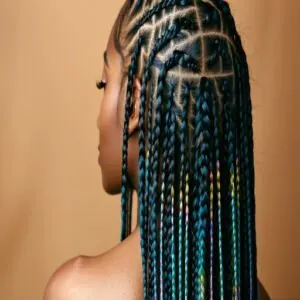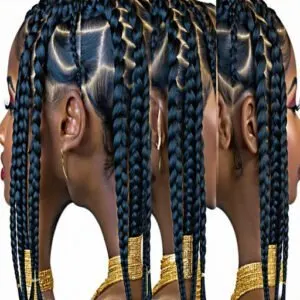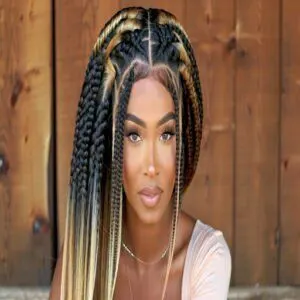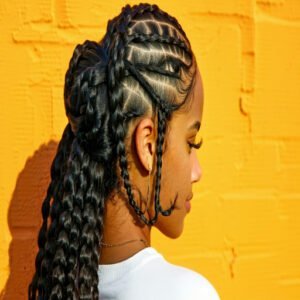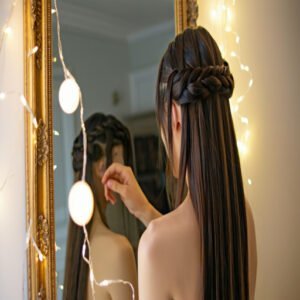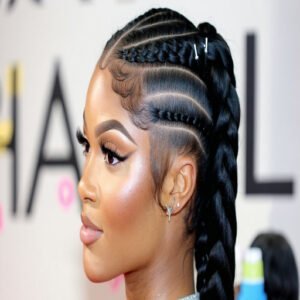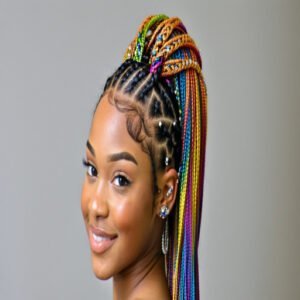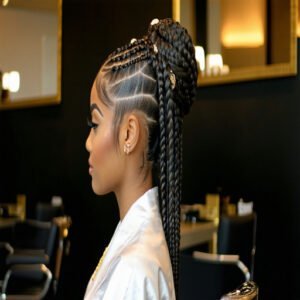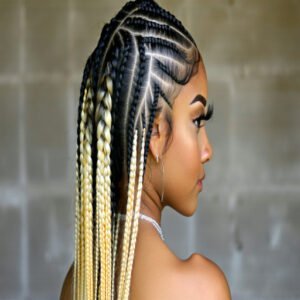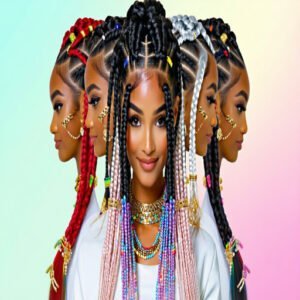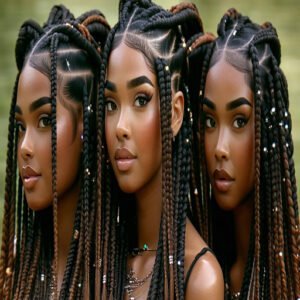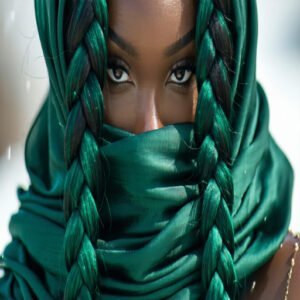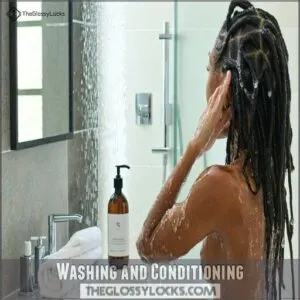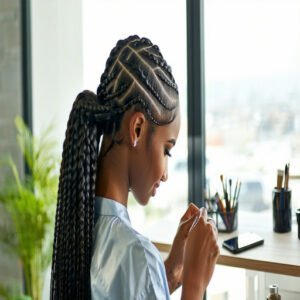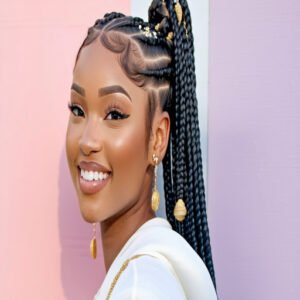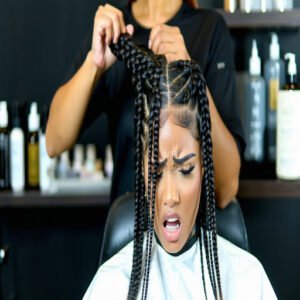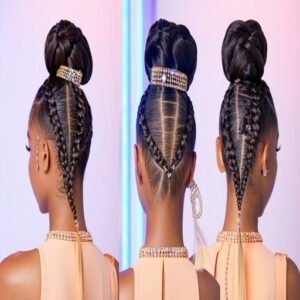This site is supported by our readers. We may earn a commission, at no cost to you, if you purchase through links.
 Feed-in braids are the ultimate blend of style and practicality, giving you a sleek, knotless look that feels as good as it looks.
Feed-in braids are the ultimate blend of style and practicality, giving you a sleek, knotless look that feels as good as it looks.
Using a clever technique to “feed” extensions into your natural hair, this hairstyle protects against breakage while adding length and volume.
Whether you’re into classic waist-length cornrows, playful curls at the ends, or accessorizing with beads and cuffs, the versatility is endless.
Plus, they’re gentle on your scalp and can last up to three weeks with proper care.
Want a hairstyle that turns heads but doesn’t pull on them, consider feed-in braids that might just be calling your name, offering a sleek appearance.
Table Of Contents
- Key Takeaways
- What Are Feed-in Braids?
- Different Styles of Feed-in Braids
- Are Feed-in Braids Right for You?
- How to Keep Your Feed-in Braids Looking Fresh
- How to Find a Skilled Braider
- Pros of Feed-in Braids
- Cons of Feed-in Braids
- How Long Do Feed-in Braids Last?
- How to Wash and Care for Feed-in Braids
- How to Style and Maintain Feed-in Braids
- Frequently Asked Questions (FAQs)
- How long does feed in braids last?
- What is the feed in braids?
- What is the difference between cornrows and feed in braids?
- What is the difference between feed in and stitch braids?
- Can I swim with feed-in braids?
- What type of hair is best for feed-in braids?
- Can I wear my feed-in braids in a high ponytail?
- How long does it take to install feed-in braids?
- Can I add beads or accessories to my feed-in braids?
- Can feed-in braids damage natural hair?
- Conclusion
Key Takeaways
- Feed-in braids give you a sleek, knotless look by gradually adding extensions, reducing tension on your scalp, and protecting against breakage.
- They’re versatile with styles like high buns, curly ends, and added accessories like beads or cuffs to customize your look.
- Proper maintenance, like keeping your braids moisturized, protecting them at night with a satin scarf, and using lightweight products, can extend their lifespan.
- They typically last about 2-3 weeks but require skilled installation, as tight braids or poor technique can cause scalp damage or hair breakage.
What Are Feed-in Braids?
Ever feel like your hair needs a vacation too?
That’s where feed-in braids come to the rescue.
This braid technique seamlessly adds extensions into your natural hair, strand by strand, creating a sleek, knotless finish.
Forget scalp tension—these braids are gentle and downright comfortable.
That’s why they’ve become a go-to protective style.
The “feed-in” method keeps things natural by blending hair extensions gradually, so your braids look smooth, not bulky.
Plus, you’ve got endless options—go bold with waist-length cornrows or funky with colorful accents.
Bonus: They help protect your hair and reduce breakage.
To master feed-in braids, understanding basic braiding techniques is essential for achieving a polished look.
Wondering about materials?
Pre-stretched braiding hair, like kanekalon, is your MVP.
Feed-in braids aren’t just a style—they’re freedom in every strand.
Different Styles of Feed-in Braids
Whether you’re into bold, chunky braids or sleek, intricate patterns, feed-in braids offer endless ways to express your style.
From Fulani-inspired rows to playful blonde-tipped designs, there’s a look for every vibe and occasion.
Feed-in Fulani Braids
Feed-in Fulani braids are like little works of art for your hair.
Inspired by the rich cultural significance of the Fulani tribe in West Africa, these feed-in braids combine intricate braid patterns with pops of braid accessories like beads or cuffs.
The fusion of thin and thick braids makes this style a head-turner, whether you’re rocking it in an updo or letting it flow freely.
Plus, they blend seamlessly with your natural hair texture when done right, and if you’re up for tribal feed-in braids with a modern twist, this style’s unbeatable, but just a heads-up: they’re trendy but can tug a bit on your scalp.
Barrel Braids
If you’re looking for feed-in braids with flair, barrel braids might just steal the show.
They’re all about bold patterns and layering, adding texture and movement to any hair texture.
Whether your day calls for a chic, messy braid-up or wearing them loose, this style is versatile enough to fit the vibe.
To keep barrel braids looking fresh, stick to braid-friendly shampoos and gentle conditioning.
Use styling tools like satin scarves overnight to reduce frizz.
With proper care and smart braiding techniques, these beauties can last around two weeks—making them the fuss-free style you’ll keep going back to.
Classic Feed-in Braids With Curly Ends
Classic feed-in braids with curly ends are the perfect mix of sleek and playful.
The curls add a fun twist that screams personality while still being versatile.
To keep those curls popping:
- Moisturize regularly with leave-in conditioner or curl cream.
- Detangle gently using your fingers or a wide-tooth comb—no rough tugging!
- Avoid heat tools to protect the hair texture and prevent frizz.
- Wrap your hair up at night with a satin bonnet for longevity.
Feed-in braids with curly ends? Total win for effortless style!
Half Up Half Down Feed-in Braids
Why choose just one style when you can rock the best of both worlds?
Half up, half down feed-in braids are all about versatility and flair.
Whether you’re running errands or heading to a party, this look delivers effortlessly.
Here are three trend-setting ideas to try:
- Curly Ends for a Glam Vibe: Add curls to the ends for that soft, chic finish.
- Face-Framing Bangs: Personalize your look with braided bangs to highlight your facial features.
- Beginner-Friendly Style: Keep it simple with sleek braid patterns and minimal styling tools for an easy win.
Large Feed-in Braids for Long Hair
Big braids, bold moves—large feed-in braids for long hair are all about statement-making.
They amplify every inch of your hair length and texture with effortless braid patterns.
Here’s how you can style them:
- Thick upwards feed-in braids
- Large feed-in braids with twists
- Sleek buns
- Dramatic pigtails
- Waterfall-inspired designs
- Long, goddess braids
- Classic French patterns
- Traditional cornrows
Want them to last? Keep your scalp moisturized, wrap your braids at night, and use gentle products to wash and condition.
These braids turn heads while keeping your hair protected.
Feed-in Braids With a Low Bun
When you want a polished yet effortless vibe, feed in braids styled into a low bun are a game-changer.
This trendy look is easy to pull off but packs serious elegance.
Here’s how to nail it:
- Gather your braids at the nape of your neck—make sure they’re smooth for that sleek finish.
- Twist or wrap the braids into a bun, keeping the braid texture visibly chic.
- Secure with bobby pins or a stylish hair tie.
- Add edge control or cute hair accessories for flair!
Feed in braids updo hairstyles like this? Always perfect for any occasion.
Stylish Feed-in Braids
Switching up your look with stylish feed-in braids isn’t just easy—it’s fun.
Think of them as the blank canvas where your creativity runs wild.
Love face-framing layers? Try feed-in braids with bangs.
Into a boho vibe? Add beads or hair jewelry to personalize it.
With endless braid patterns, you’ll never feel stuck in one style.
Play with textures, colors, or accessories to match your vibe.
Feeding in twists or experimenting with bold braid accessories can make your style truly yours.
| What It Brings |
|---|
| Bangs |
Feed-in Braids High Bun
When you’re ready to turn heads, a feed-in braided bun is the ultimate power move.
A high bun takes feed-in braids to the next level, blending elegance with practicality.
Whether you’re running errands or dressing up for date night, this braided updo commands attention while keeping your hair perfectly in place.
The beauty of a high bun is its versatility—rock it sleek and polished, or leave a few braids loose for a playful, effortless vibe.
Looking for updo inspiration? Add a braided crown or weave in bold hair accessories like cuffs or gems for a touch of glam.
High bun variations also pair well with baby hairs styled into soft swoops for a polished finish.
Use these bun styling tips: secure with pins and edge control, and don’t forget a satin wrap at night for maximum longevity.
Feed-in Braids With Blonde Tips
Thinking about spicing up your feed-in braids? Blonde tips are where it’s at! This bold trend blends perfectly with natural tones or pops brilliantly against darker hair.
Ready to rock this vibe? Here’s how to keep your blonde feed-in braids flawless:
- Pick the perfect shade: From platinum to honey, choose what complements you.
- Mix textures: Pair blonde tips with feed-in braids with curly hair.
- Stay vibrant: Use braid maintenance tips for color care.
- Experiment: Try half-up styles or playful twists!
Blonde braid trends? Nailed it.
Feed-in Braids Cuffs
After rocking blonde tips, why not take things up a notch with braid accessories? Braids with cuffs are like adding jewelry to your hair—elevating your feed in braids with a touch of shine and creativity.
From classy gold and silver cuffs to colorful beads or quirky charms, there’s a cuff design for everyone.
Just slide them onto your braids, and boom—instant glam!
Here’s a quick cheat sheet to pick your perfect braid embellishments:
Material
Vibe
Best For
Where to Buy
| Price Range |
|---|
| Gold Metal |
Adding cuff designs opens up a world of feedin braid styles—stylish, simple, and full of personality!
Are Feed-in Braids Right for You?
Not all protective styles are a one-size-fits-all deal, and feed-in braids are no exception.
They’re perfect if you’re after a sleek, trendy look, but they come with considerations.
First, Braid Suitability: coarser hair textures usually hold feed-in braid styles better, while finer hair might struggle to keep them neat for long.
Scalp Health is another factor—if your scalp is sensitive or your edges are delicate, the tension from feed-in braiding techniques could be uncomfortable.
And let’s talk Braid Durability: feed-in braids typically last about two weeks, so don’t expect a month-long style.
Understanding the basics of natural hair care is essential for maintaining healthy hair while wearing feed-in braids.
Thinking about feed in braids for women? Here’s a quick gut-check:
- Hate sitting for hours? These take time.
- On a budget? Feed-in braids vs traditional knots can cost more.
- Love creative flair? This style nails it with endless personal tweaks.
Bottom line: your hair, your rules—just consider your texture, budget, and scalp.
How to Keep Your Feed-in Braids Looking Fresh
You’ve invested time and money in your gorgeous feed-in braids, so let’s make sure they stay fresh and fabulous for weeks to come.
With the right mix of protective techniques and daily maintenance tricks, you’ll keep your braids looking so sleek that your friends will think you just left the salon.
Maintaining Moisture
Your feed-in braids need moisture like plants need water.
The secret to keeping your natural hair thriving under those protective styles is all about hair hydration that works smarter, not harder.
A light, water-based spray keeps your scalp happy without weighing down your braids.
Proper maintenance can extend the life of your style, as seen in this helpful feed-in braid guide.
To keep your scalp and braids healthy, consider the following tips:
- Massage in lightweight oils every 2-3 days using an applicator bottle for precise scalp care
- Mix aloe vera and water in a spray bottle for a quick moisture boost
- Apply leave-in conditioner before bed for overnight hair moisture
- Use tea tree or jojoba oil to nourish your scalp while controlling frizz
A light, water-based spray keeps your scalp happy without weighing down your braids.
Protecting The Braids
Every night’s beauty sleep demands proper braid security.
Wrap your feed-in braids in a silk or satin scarf to prevent friction and preserve those edges.
For extra hair preservation, try a bonnet with an adjustable band that won’t slip off.
During workouts, use a moisture-wicking headband to protect your scalp and keep those protective braids looking fresh.
At the beach, shield your braids with a stylish head wrap.
Washing and Conditioning
Your natural hair needs love, even under those gorgeous feed-in braids.
Start with proper scalp care using a gentle braid shampoo every 1-2 weeks to keep your roots fresh.
Here’s your fail-proof washing routine:
- Mix a sulfate-free shampoo with water in a spray bottle for gentle cleansing that won’t disturb your braided hair
- Apply a lightweight conditioner from mid-length to ends, carefully avoiding the roots where extensions meet natural hair
- Seal in hair moisture with a water-based product, followed by a light oil to keep your braids silky smooth
Using distilled water benefits can also promote healthier-looking hair by removing mineral buildup and chlorine from tap water.
Remember to detangle with your fingers – leave those brushes alone until wash day comes around again.
How to Find a Skilled Braider
You’ll want to check out your potential braider’s Instagram portfolio before trusting them with your crown, since a skilled artist will proudly showcase their feed-in masterpieces with clear, well-lit photos from multiple angles.
When you’re ready to book, don’t forget to read recent reviews and ask friends for recommendations, because finding the right braider is like finding the perfect jeans – it might take some searching, but it’s totally worth it for that perfect fit.
Online Platforms and Directories
When it’s time for fresh feed-in braids, reliable braider directories like Yelp and LocalBraid can be your best friends.
You’ll find detailed online reviews from real clients, making it easier to spot talented pros near you, and browse through directory listings to compare feed-in braiding techniques and pricing.
Join hair forums like Salon Geek to get insider tips, and check licensing requirements in your area.
The right platform can connect you with a skilled braider who’ll nail your desired look, and don’t forget to explore specialty marketplaces that focus on protective styles.
Social Media and Hashtags
Scrolling through Instagram or TikTok? Social media is hands-down the go-to for spotting braiders who’ve mastered feed in braids.
Jump on the influencer marketing bandwagon and explore trending hashtags to find your match.
From sleek feed in braids hairstyles 2024 to bold feed in braid styles, there’s something for everyone.
- Mix general hashtags like #braids or #blackhair with location-based ones like #BraiderInLA.
- Explore online communities and content creation posts under #feedinbraids2025.
- Engage with stylists using social sharing – comment, like, and DM them!
Word of Mouth
Nothing beats personal referrals in the matter of finding someone who nails feed in braid styles.
Ask your family, friends, or even coworkers about their go-to braiders.
Social proof matters—those glowing customer testimonials and community feedback can save you from a bad hair day.
Not sure how to start, compliment someone rocking perfect feed in braids and ask who did it, people love sharing their hidden gems.
You’ll get insights about pricing, technique, and even scalp-friendly styling practices.
Salon Visits
Popping into a salon can sometimes feel like speed-dating for your hair, but it’s worth it to find the perfect match for your feed-in braids.
When scoping salons, keep these tips in mind:
- Ask for photos: A solid portfolio is like a braider’s dating profile—proof they can nail feed in braiding techniques.
- Discuss pricing: Know the cost of their braiding services to avoid sticker shock.
- Gauge experience: Confirm they’ve mastered feed in braids vs traditional styles.
- Check salon etiquette: Is the space clean? Do they respect appointment scheduling?
Use your visit to chat about stylist communication and what to expect. Look for someone who listens—your dream feed in hair braiding styles depend on it!
Pros of Feed-in Braids
Feed-in braids are like a triple win for your hair—they protect, add instant length, and give you endless styling options.
Whether you’re after sleek, long cornrows or chunky braids with bold accessories, this style does it all while staying gentle on your scalp, making it a gentle option.
Protective Hairstyle
Think of feed-in braids as your hair’s BFF—it’s like wrapping your strands in a safety blanket.
These protective hairstyles shield your natural hair from breakage while promoting scalp health and hair growth.
With their knotless design, feed-in braids are gentle, reducing tension and stress.
Plus, they’re super versatile, adapting to different cornrow styles or hair textures.
With care and braid maintenance, you’ll keep this natural hairstyle looking flawless, and since feed-in braids are a type of protective hairstyles, they offer multiple benefits.
Added Volume and Length
There’s something magical about the instant volume and length you get with feed-in braids.
This technique adds hair extensions right into your natural strands, creating a fuller, longer look.
Whether you’re going for thick upwards feed-in braids, jumbo feed-in braids, or large feed-in braids with twists, the options feel endless.
Embrace the magic of these volume techniques:
- Thin hair? Add braid thickness for a bold transformation.
- Dreaming of long hair? Try long feed-in braids for a dramatic vibe.
- Extra volume crush? Go for thickening methods for stunning twists.
- Scalp comfort? Enjoy tension-free styling that promotes hair health.
Versatile Styling Options
Feed-in braids are pure magic in the context of switching up your look.
They’re super flexible, effortlessly transforming into fun updos, sleek ponytails, or casual half-down vibes.
Options? Endless! By understanding the benefits of hair growth factors, you can make informed decisions about your braiding choices.
- Pair with braid accessories like cuffs or beads for extra flair.
- Works with all hair textures, from silky to coarse.
- Play with bold color options or intricate braid patterns.
Cons of Feed-in Braids
Let’s be real—feed-in braids aren’t all fun and glam.
They can tug on your scalp, drain your wallet, and take forever to put in,
so it’s good to know what you’re signing up for!
Potential Scalp Tension
A tight braid might look sleek, but it’s no joke for scalp sensitivity.
Overly tight feed-in braids can cause tension, leading to hair breakage or even traction alopecia (fancy term for bald spots nobody wants).
Make sure your braider keeps things scalpfriendly—not a tug-of-war with your hair.
Feeling discomfort? Speak up! And when it’s time for braid removal, treat your scalp with care—no yanking!
A little scalp care goes a long way toward tension relief and keeping your hair healthy.
Cost and Time Investment
Braiding Costs aren’t just about cash—they’re about your time, too.
Feed in braids give you that sleek, versatile vibe, but you’ll need some patience.
Salon Fees can range from $65 to over $200 depending on the style—think feed in braids with designs or feed in braids with twists.
Installation takes hours, so clear your schedule.
On top of that, your Maintenance Budget includes oils, moisturizers, or edge control to keep things fresh.
Here’s the breakdown:
- Salon Fees vary based on complexity.
- Expect 3–5 hours for styling, depending on braid size.
- Products for upkeep add extra money.
- DIY removal takes care and loads of time.
Difficulty in Removal
Taking out feed-in braids, especially tighter styles like feed-in braids with curly hair, can feel like wrestling with a tangle of vines.
Ripping them out yourself is a bad idea. That’s a fast track to hair damage or a sore scalp.
Use gentle takeout methods or call a pro—they’ve got the touch to avoid breakage or tearing.
Massage some oil into your braids while you work for easier removal and soothing your scalp.
Show your hair love with post-removal care like conditioning treatments!
How Long Do Feed-in Braids Last?
How long do feed-in braids last? Typically, you’re looking at about two weeks of fabulousness, but with some TLC, they can stretch to three.
Factors like hair growth, braid longevity tricks, and scalp health play a big role.
- Feed-in Care: Protect them at night with a satin scarf to combat frizz.
- Hair Growth: As new hair emerges, expect some loosening.
- Braid Longevity: Hire a pro for a solid installation.
- Braid Removal: Undo carefully to avoid breakage.
Keep your feed-in braids hairstyles 2024-worthy!
How to Wash and Care for Feed-in Braids
Keeping your feed-in braids clean and fresh doesn’t have to be a hassle if you’ve got the right tricks up your sleeve.
From gentle washes to protecting them at night, a little care goes a long way in keeping your style sleek and lasting.
Shampooing and Conditioning
Keeping your feed-in braids looking fresh starts with proper shampooing and conditioning.
A little TLC here will go a long way in braid cleansing and maintaining your natural hair’s health.
- Pick a gentle shampoo. Massage it into your scalp (not the braids!) for a soothing cleanse.
- Condition strategically. Apply a tiny amount along the braid’s length, focusing on the ends—overdoing it can leave your braids limp.
- Deep condition bi-weekly. Moisturizing techniques like this combat dryness and nourish your hair.
- Refresh between washes. Try dry shampoo sparingly or dab a damp cloth to keep your scalp feeling flawless.
For ideal braid care, using the right braid shampoo products can make a significant difference in the overall health and appearance of your braids.
Your braids deserve finesse—treat ’em right!
Moisturizing The Scalp
Your scalp deserves love too!
Keep the moisture balance in check by using lightweight hair oils like jojoba or tea tree.
They’re stellar for relieving an itchy scalp and preventing dry flakes.
Gently massage the oil between your feed-in braids for ultimate hydration.
This quick hair care trick keeps your natural hair happy and guarantees your braiding hair stays flawless!
For superior results, consider using products from hair oil products to maintain a healthy scalp.
Protecting The Braids at Night
Don’t let bedtime be the villain to your perfect feed-in braids!
A satin scarf or braid sleeve keeps your braids snatched, while silk pillowcases are your backup plan against frizz.
Protective hairstyles for kids? Use braid covers—they stay put during wiggle-filled nights.
These simple tricks shield your braiding techniques and hair care routine, ensuring sleek braids for days.
Avoiding Frizz and Tangling
Keeping your feed-in braids smooth and frizz-free isn’t rocket science—it’s all about smart care.
Spritz your scalp lightly with water or leave-in conditioner to lock in moisture.
Gently work a lightweight oil, like jojoba or argan, into your scalp for added hydration.
When washing, handle your braids as if they’re silk—no tugging!
Use conditioner to reduce friction, rinse carefully, and pat dry.
Trust me, these braid care tips will keep your braiding techniques flawless, ensuring sleek braids for natural hair!
How to Style and Maintain Feed-in Braids
Mix up your look with feed in braids by trying sleek high buns, dramatic side braids, or playful cornrow pigtails.
Use braid accessories like cuffs or gems for flair.
Keep things fresh with solid scalp care: oil your roots weekly and sleep on a satin pillowcase to fight frizz.
Hair texturing tools can switch things up—try wave irons for added depth.
Mastering basic braiding techniques is essential for creating various styles.
Re-braid every 2-3 weeks to reinforce style and prevent breakage.
Proper removal? Be patient, gentle, and grab some oil!
Frequently Asked Questions (FAQs)
How long does feed in braids last?
Funny how two weeks can feel like forever when your braids start loosening, right?
Feed-in braids last about 2 weeks, but regular upkeep with edge control and a satin bonnet keeps them looking fresh.
What is the feed in braids?
Imagine thick, sleek braids that look totally natural—no bulky knots or tugging on your scalp.
That’s feed-in braids for you!
They blend extensions smoothly into your hair, giving you endless styling options with a flawless finish.
What is the difference between cornrows and feed in braids?
Cornrows start at the scalp and form neat, raised rows.
While feed-in braids gradually “feed” extensions for a natural, seamless look.
Feed-ins create a softer finish, perfect if you love versatile, flowing styles!
What is the difference between feed in and stitch braids?
Stitch braids create crisp, defined sections using strong parting techniques, while feed-in braids give a natural, seamless look by adding hair gradually.
Stitch braids scream precision; feed-ins feel effortless.
Pick what vibe suits you best!
Can I swim with feed-in braids?
You totally can swim with feed-in braids.
Just rinse them afterward to avoid chlorine or salt build-up.
A swim cap helps protect them too—because let’s face it, no one wants crunchy braids.
What type of hair is best for feed-in braids?
You know what’s golden for feed-in braids? Pre-stretched kanekalon hair.
It blends like a dream, prevents unraveling, and eases the process.
Bonus: It’s lightweight and lasts, so you’re not stuck fixing frizz every other day, which makes kanekalon hair a great choice.
Can I wear my feed-in braids in a high ponytail?
A high ponytail with feed-in braids looks sleek and stunning.
Just be gentle pulling it up to avoid tension on your scalp.
Add a scrunchie or hair cuffs for extra flair!
How long does it take to install feed-in braids?
How long it takes depends on the style, but most feed-in braids take about 2-4 hours.
Complex designs or smaller braids might need extra time, so bring snacks or something to binge-watch while you wait!
Can I add beads or accessories to my feed-in braids?
Funny how a little sparkle can change everything, right?
You can absolutely add beads, jewels, or hair cuffs to your feed-in braids.
They’re the perfect way to level up your look and express yourself!
Can feed-in braids damage natural hair?
Too-tight feed-in braids can stress your scalp and hairline, causing breakage or thinning.
Always choose a skilled stylist, speak up if it feels uncomfortable, and stick to balanced tension for healthy, happy natural hair.
Conclusion
Imagine this: your feed-in braids are like a crown—sleek, stylish, and built to last when treated with care.
Whether you’re rocking bold blonde tips, playful buns, or classic cornrows with a twist, the possibilities are endless.
Just keep them moisturized, protect them at night, and don’t skip the scalp TLC, as feed-in braids aren’t just a hairstyle; they’re a vibe, blending beauty with practicality.
So go ahead, embrace the trend, and let your hair do the talking!

